Ikkyo Complete 8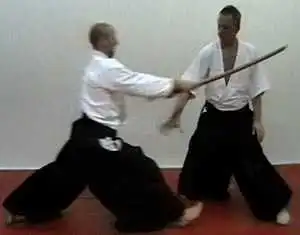 Tachidori — Defense against sword attacksTachidoriTachidori, aikido techniques against sword attacks, are difficult mainly because of the additional reach uke has with the sword, and also because of the need to control the sword all through the technique. On these video clips a bokken, the wooden sword, is used. Below are texts and video clips on ikkyo against tachi, the sword (also called to, ken, katana etc.). For sword art basics, see here: aikibatto
TachidoriTachidori ikkyo, omote and ura, on all the attack forms explained below. Many more aikido videos on my YouTube Channel.
Always in tachidori, tori must make sure to stand at enough a distance from uke in the beginning, so that uke can't reach with a quick tsuki on the spot. That means tori must make a big step in the taisabaki movement, to get inside the length of the blade. That way, if uke follows up with a quick slash to the side with the sword, it's only uke's arm hitting tori — not the blade. Tori needs to get very near uke by the first step. Since uke is also advancing, to reach tori with the attack, that is not as difficult as it might seem. Tori makes a sweeping move down uke's arm to reach and grab uke's hand. Notice that in tachidori, tori should grip uke's hand, not the wrist. If tori grabs the wrist, uke can still move the blade quite freely. In some tachidori techniques, it is more advantageous to grab the tsuka, sword handle, between uke's hands, but that's not so practical for ikkyo. Tori grabs uke's hand right next to where the tsuba, sword guard, would be. Thereby, a solid grip is possible. Since the Japanese sword is held with one hand in front of the other (usually right in front of left), ikkyo can only be done on one side — uke's left — and only on one arm — uke's right. If you enter on uke's right side, you have to choose another technique than ikkyo. If you try to do the ikkyo on uke's left arm, you can hardly control the sword. When you do the ikkyo, make sure to move uke's sword to your side. Don't let it be in front of you. Your body should be between uke's body and the sword, so that uke has little chance of using it. There are several ways to release the sword at the end of the technique. I do it so that I use leverage. Grab the tsuka with one hand, and fork your other hand halfway or more up the blade — don't grab it, or you'll cut yourself. Make a circle, without lifting uke's arm, ending with the tip of the blade pointing to uke's arm. When you learn this release, allow uke to hold on to the sword quite firmly, so you get it right. In ura, you must start the same way as omote, or it will be very difficult indeed for you to turn uke's arm in the ikkyo movement. It's only after the initial taisabaki and the grab of uke's hand, that you decide between omote and ura. Both omote and ura are on the video clip.
Yokomenuchi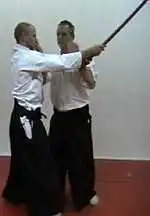 At the yokomen attack, tori enters in much the same way as with any gyakuhanmi relation attack. With one hand, tori makes an atemi to uke's face, with the other an outward parrying move to extend uke forward.
At the yokomen attack, tori enters in much the same way as with any gyakuhanmi relation attack. With one hand, tori makes an atemi to uke's face, with the other an outward parrying move to extend uke forward.Usually ikkyo should be done by grabbing uke's wrist from below, but here it is safer to do from above — in the same manner as with gokyo. Otherwise, it is difficult for tori to control the sword. Ikkyo can be done with a wrist grip from below, since the yokomenuchi attack is high, but still it is more trustworthy to do the gokyo style grab. In the case of yokomenuchi, it's not as convenient as with shomenuchi to grab uke's hand instead of the wrist, because of the diagonal angle of the attack. Then, a wrist grip is more practical. You should try to make that grip close to uke's hand, so that uke does not easily move the sword. About the release of the sword at the end of the technique, see shomenuchi above. Just like with ikkyo on other attack forms, ura starts the same way as omote, or it would be difficult to bring uke's arm into the ikkyo move. Both omote and ura are on the video clip.
Chudan tsuki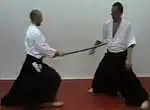 The initial taisabaki movement away from chudan tsuki is the same as at shomen and yokomen attacks. Sword attacks can be very quick, and it's hard to have time to adapt to different attacks already at that first move, so it makes sense to learn one and the same evasive movement for them all. Make sure to advance to a position quite close to uke, inside the reach of the blade.
The initial taisabaki movement away from chudan tsuki is the same as at shomen and yokomen attacks. Sword attacks can be very quick, and it's hard to have time to adapt to different attacks already at that first move, so it makes sense to learn one and the same evasive movement for them all. Make sure to advance to a position quite close to uke, inside the reach of the blade.On tsuki attacks it is quite possible to grab uke's wrist from below instead of above. Try both. On this video clip, the grab from below is used. It might be the most practical one, since uke is moving the sword forward instead of down, and might also pull it back right after the strike. When grabbing uke from below, it's difficult to get that grip on the hand, near the tsuba. Grab the wrist instead, but try to be so near the hand that your grip makes it hard for uke to move the sword. Just like with the above techniques, make sure to put your body between uke's body and the sword. Not only does it block uke from using the sword, but also you can use your body weight effectively to bring uke down. This video clip shows chudan tsuki, which aims for the solar plexus. Jodan tsuki aims for the throat or face, which is not that much of difference in the angle as one might think. Still, since uke's arms are a bit higher, the grab from below is even easier than on chudan tsuki. Both omote and ura are on the video clip.
Yokogiri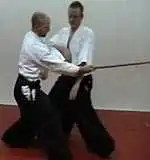 Yokogiri, the side cut, is also called do — especially in kendo. It can be horizontal or diagonal, aiming somewhere between above the hip and below the shoulder. A similar cut is kesagiri, going diagonally from the neck down. Ikkyo is done the same way on them all. On this video clip a horizontal yokogiri is used.
Yokogiri, the side cut, is also called do — especially in kendo. It can be horizontal or diagonal, aiming somewhere between above the hip and below the shoulder. A similar cut is kesagiri, going diagonally from the neck down. Ikkyo is done the same way on them all. On this video clip a horizontal yokogiri is used.Here it is quite essential to move boldly forward to a position very near uke. That's to make sure to avoid the blade. Keep your arm low, not as much to protect from uke's cut as to make sure it is halted. With your other hand, make an atemi to uke's face. Grab uke's wrist from above, in a gokyo manner. Because of the angle of uke's hands in this attack, it's not so practical to try to grab the hand. Try to hold the wrist in such a way that uke can't move the sword. After grabbing uke's wrist you can choose between omote and ura. Both omote and ura are on the video clip.
Stefan Stenudd
IKKYO COMPLETE
AIKIDO PRACTICEIntroductionAikido Techniques — all the basic movesAttacks in Aikido
Tantodori — knife defenseAikiken — aikido sword techniquesJo 31 Kata in four directionsAikibatto sword and staff exercisesAiki — joining energiesKi exercisesAikido Video ClipsAikido PhotosMy aikido dojo in Malmö, SwedenMy aikido seminarsAIKIDO THEORYMy Aikido BioAikido GlossaryTanden, the CenterAikido InksAikido as Self-DefenseRunning a DojoAikido is TrueOsensei and EinsteinAikiWeb ColumnsAikido Books ReviewedDie deutsche Version meines Aikido-Buches onlineAikido på svenskaAbout CookiesMy Other WebsitesCREATION MYTHSMyths in general and myths of creation in particular.
TAOISMThe wisdom of Taoism and the Tao Te Ching, its ancient source.
LIFE ENERGYAn encyclopedia of life energy concepts around the world.
QI ENERGY EXERCISESQi (also spelled chi or ki) explained, with exercises to increase it.
I CHINGThe ancient Chinese system of divination and free online reading.
TAROTTarot card meanings in divination and a free online spread.
ASTROLOGYThe complete horoscope chart and how to read it.
MY AMAZON PAGE
MY YOUTUBE AIKIDO
MY YOUTUBE ART
MY FACEBOOK
MY INSTAGRAM
STENUDD PÅ SVENSKA
|
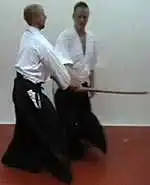
 Aikido Principles
Aikido Principles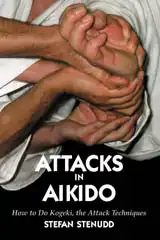 Attacks in Aikido
Attacks in Aikido Aikibatto
Aikibatto
